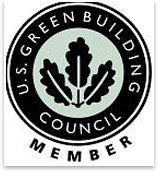
 USGBC Ups LEED Green Building Rating System Requirements to Increase Energy Performance by 14 Percent USGBC Ups LEED Green Building Rating System Requirements to Increase Energy Performance by 14 PercentSummary: To meet its Climate Change Agenda, the U.S. Green Building Council’s (USGBC) membership last month voted to require all LEED®-certified projects to achieve at least two “Optimize Energy Performance” points within LEED, which the council estimates will improve the energy performance of all LEED-certified green buildings by 14 percent for new construction and 7 percent for existing buildings. Effective immediately, all newly registered commercial LEED projects will be required to achieve the two “Optimize Energy Performance” points, which will count towards a project's certification.
The Climate Change Agenda
USGBC estimates that, by 2010, there will be 100,000 LEED-certified commercial buildings and a million certified homes. By 2020, there will be a million LEED certified commercial buildings and 10 million certified homes.
|
||
Copyright 2007 The American Institute of Architects. All rights reserved. Home Page |
||
news headlines
practice
business
design
Recent related
› USGBC Walks Their Talk
View the energy optimization section of LEED.
For more information on USGBC or LEED visit www.usgbc.org.
Pictured is the interior of the new U.S. Green Building Council’s headquarters in Washington, D.C., which has achieved the highest LEED® rating for its interiors. The Platinum Commercial Interiors office suite was designed by the D.C. office of Perkins + Will. Photo © Prakesh Patel.

 The new requirement will reduce the environmental and economic impacts associated with excessive energy use and maximize energy performance of buildings through cost-effective energy efficiency measures, according to the USGBC. To help projects achieve the new energy reduction requirements, a prescriptive compliance path is currently under development as an alternative to energy modeling.
The new requirement will reduce the environmental and economic impacts associated with excessive energy use and maximize energy performance of buildings through cost-effective energy efficiency measures, according to the USGBC. To help projects achieve the new energy reduction requirements, a prescriptive compliance path is currently under development as an alternative to energy modeling.